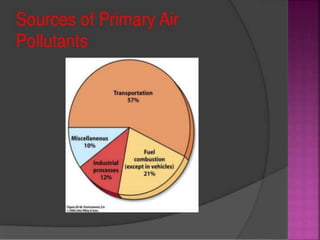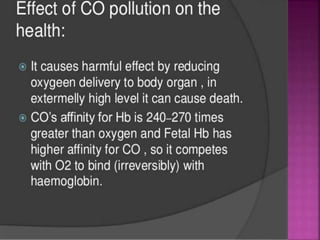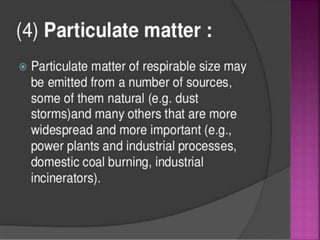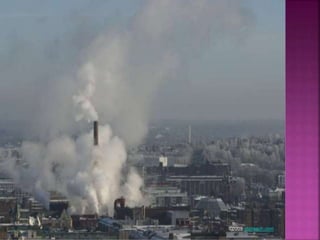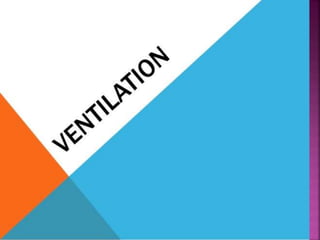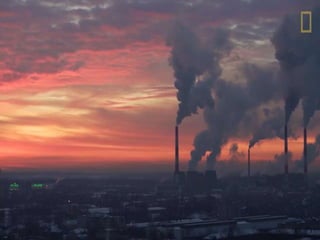Air Lecture
- 3. Air is a mechanical mixture of gases. The normal composition of external air by volume is approximately as follows: Nitrogen - 78.1 per cent; Oxygen - 20.93 per cent; Carbon dioxide - 0.03 per cent. The balance is made up of other gases which occur in traces, e.g., argon, neon, krypton, xenon and helium. In addition to these gases, air also contains water vapour, traces of ammonia and suspended matter such as dust, bacteria, spores and vegetable debris.
- 5. Air is rendered impure by· ( 1) Respiration of men and animals (2) Combustion of coal, gas, oil, etc. (3) Decomposition of organic matter and (4) Trade, traffic and manufacturing processes which give off dust, fumes, vapours and gases
- 6. This is brought about by certain self-cleansing mechanisms which operate in nature (1) Wind: Wind dilutes and sweeps away the impurities by its movement. Because of wind movement, impurities do-not accumulate in any one place; (2) Sunlight : The atmospheric temperature and sunlight play their own part by oxidizing impurities, and killing bacteria; (3) Rain : It cleanses the atmosphere by removing the suspended and gaseous impurities; 4) Plant life : The green plants utilize the carbon dioxide and generate oxygen; this process is reversed during the night time. When the rate of
- 7. Human occupancy and activity vitiate air in occupied rooms and give a sense of discomfort to the occupants. The changes in air that take place in confined places are both chemical and physical. (a) CHEMICAL CHANGES (b) PHYSICAL CHANGES
- 8. The air becomes progressively contaminated by carbon dioxide and the oxygen content decreases due to metabolic processes. An average person at rest gives off 0. 7 c.ft. of carbon dioxide per hour; this may increase up to 2 c.ft. during physical activity. In a mixed gathering comprising all age groups, the per capita output of carbon dioxide is taken as 0.6 c.ft. per hour.
- 9. (i) Rise in temperature (ii) Increase of humidity (iii) Decrease in air movement (iv) Body odours (v) Bacterial pollution Unless the vitiated air is replaced by fresh air, it may adversely affect the comfort, health and efficiency of the occupants. It is known that a feeling of suffocation or discomfort is experienced by the occupants in insufficiently ventilated rooms and also· complaints of headache, drowsiness and inability to concentrate. There is also the risk of droplet infection and lowered resistance to disease (on prolonged exposure).
- 10. Discomfort is a subjective sensation which people experience in ill-ventilated and crowded rooms. For a Jong time it was believed to be due to increased carbon dioxide and decreased oxygen, resulting from respiration. This theory has since been refuted . Studies have shown that the oxygen content may be reduced to 18 per cent and the carbon dioxide content may be raised to over 5 per cent , without adverse effects, provided the temperature and humidity are kept satisfactory.
- 11. In the 'Black Hole of Kolkata', 146 prisoners were imprisoned in a room, 18 x 14 x 10 out of whom only 23 survived. There were two small windows which were adequate to supply all the oxygen needs even then only 23 survived. It was concluded that the deaths were due to changes in the physical condition of the air, leading to 'heat retention'. It is now established that the causes of discomfort are not due to chemical changes but physical changes. These are temperature, humidity, air movement and heat radiation. These factors determine the "cooling power" of the air with respectto the human body. It has been so well said by Professor Lee that "The problems of ventilation are physical, not chemical; cutaneous not respiratory.
- 12. (1) AIR TEMPERATURE (2) AIR TEMPERATURE AND HUMIDITY (3) COOLING POWER (4) EFFECTIVE TEMPERATURE (5) CORRECTED EFFECTIVE TEMPERATURE
- 13. Corrected effective temperature deg C 1. Pleasant and cool -----------------20 2. Comfortable and cool ------------20-25 3. Comfortable -----------------------25-27 4. Hot and uncomfortable ----------27-28 5. Extremely hot----------------------28+ 6. Intolerably hot -------------------30+
- 14. Effective temperature 25-27degree c Relative humidity 30-65 % Dry kata 6 or above Wet kata 20 or above
- 66. 1.Acid rain 2.Global warming causing – -Increase green house effect -Reduction of food -Increase melting of polar icecap -Increase sea level –flood -Smog formation -Increase in cancer
- 74. The methods employed are : (1) MECHANICALVENTILATION : This reduces vitiated air and bacterial density. (2) ULTRAVIOLET RADIATION : This has been found to be effective in special situations such as operation theatres and infectious disease wards. Since direct exposure to ultraviolet rays is a danger to the eyes and skin, the ultraviolet lamps are shaded and located in the upper portion of the rooms near the inlet of air. Ultraviolet rays have proved effective for general use in public assembly and school rooms.
- 75. (3) CHEMICAL MISTS : Triethylene glucol vapours have been found to be effective air bactericides, particularly against droplet nuclei and dust. (4) DUST CONTROL : Application of oil to floors of hospital wards reduces the bacterial content of the air. Air disinfection is still in the experimental stage
- 77. The modern concept of ventilation implies not only the replacement of vitiated air by a supply of fresh outdoor air, but also control of the quality of incoming air with regard to its temperature, humidity and purity with a view to provide a thermal environment that is comfortable and free from risk of infection.
- 83. 1. NATURAL VENTILATION (1) THE WIND : The wind is an active force in ventilation. When it blows through a room, it is called perflation. When there is an obstruction, it bypasses and exerts a suction action at its tail end - this is called aspiration. Doors and windows facing each other provide "cross-ventilation". Back to back houses do not permit _cross ventilation and therefore, their construction is not allowed. (2) DIFFUSION : Air passes through the smallest openings or spaces by diffusion. This is a slow process and therefore, is not relied upon as the sole means of ventilation
- 84. (3) INEQUALITY OF TEMPERATURE: Air flows from high density to low density; it rises when slightly heated and escapes from openings provided high up in the room. The outside air which is cooler and more dense will enter the room through inlets placed low. The greater the temperature difference between outside and inside air, the greater the velocity of the incoming air. In the tropics the outside air may be hotter than the inside and the reverse may take place (2). These properties of air are utilized to best advantage by the proper location of windows, doors, ventilators and skylights. The chief drawback of natural ventilation is that it is not possible to regulate the velocity of the incoming air nor to adjust its temperature or humidity
- 85. 2. MECHANICAL VENTILATION : Mechanical or artificial ventilation may be of the following types : (1) Exhaust ventilation. (2) Plenum ventilation. (3) Balanced ventilation. (4) Air conditioning
- 86. (1) EXHAUST VENTILATION : In this system, air is extracted or exhausted to the outside by exhaust fans usually driven by electricity. As air is exhausted, a vacuum is created which induces fresh air to enter the room through windows, doors and other inlets. . (2) PLENUM VENTILATION : In this system, fresh air is blown into the room by centrifugal fans so as to create a positive pressure, and displace the vitiated air.
- 87. (3) BALANCED VENTILATION: This is a combination of the exhaust and plenum systems of ventilation. The blowing fan must balance the exhaust fan.
- 89. Large institutions or hospitals often install central airconditioning system for entire building, instead of installing equipments for individual rooms. Better controls and economy is achieved in central airconditioning. Where the temperature difference is large between outside atmosphere and airconditioned room, "transition room" is sometimes provided, which maintains temperature in between the two, so as to prevent sudden exposure to high or low temperature.



















